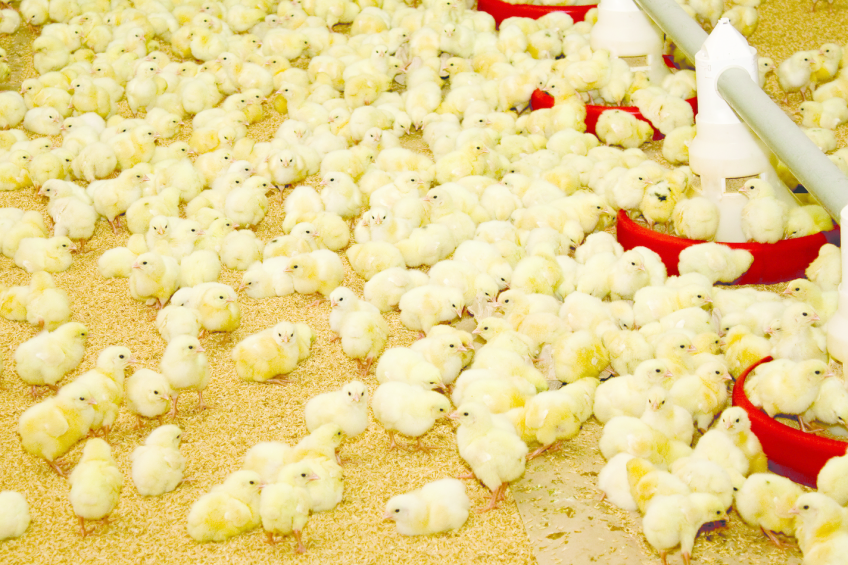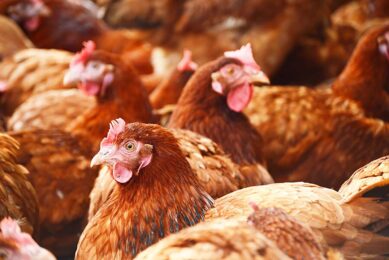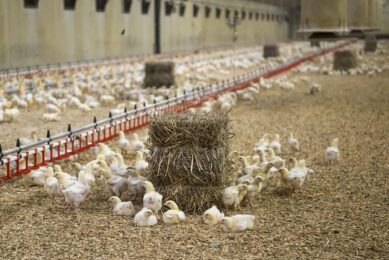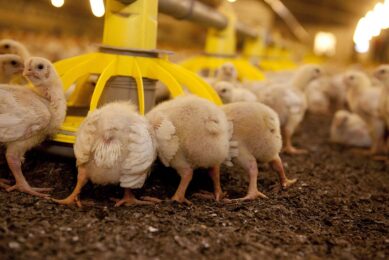Study shows Coccivac-B/Enradin disease control protocol improves flock performance and ROI

It is widely known coccidiosis and clostridia interact to hurt broiler performance. Yet there are few field reports providing economic metrics to demonstrate how controlling these pathogens improves broiler productivity. A study from MSD Animal Health reveals that changes in intestinal disease processes result in improved flock performance.
By Luis Etcharren, regional director for the Americas, MSD Animal Health
The study of 120,000 broilers, indicates successive flock vaccinations with Coccivac®-B vaccine, combined with the use of the antimicrobial, Enradin®, markedly reduced the challenge from wild strains of Eimeria spp. while controlling secondary infection with C. perfringens, especially during the final heavy growth phase of the flock. The study compared flocks vaccinated with Coccivac-B and given the antimicrobial Enradin to control C. perfringens versus flocks treated with traditional in-feed anti-coccidials and the antimicrobials BMD® and generic antibiotic growth promoters (AGP). Using Flock Performance Index (FPI) as a parameter, each successive flock treated with Coccivac-B and Enradin had a higher index than the previous flock treated with the same protocol.
The greatest FPI improvement was noted when Coccivac-B/Enradin flocks were compared to flocks treated with ionophores and BMD. The FPI improvement for the Coccivac-B/Enradin treated flocks stabilised at >370 after three consecutive flock cycles while the highest index for the traditional product protocol topped out at approximately 335. Despite higher program costs, net profit for the Coccivac-B/Enradin flocks improved with each successive flock, rising US$ .071/bird when compared to the best of the traditionally treated flocks. “Vaccination with Coccivac-B changes the intestinal health dynamics in a flock,” explains Luis Etcharren, MSD’s regional director for poultry in the Americas. “Vaccination of consecutive flocks alters the coccidiosis challenge in the broiler house, allowing a sustainable, efficient coccidiosis control. In addition, Clostridium spp. control with Enradin represents added value beyond just disease control. It enhances economic performance.”
“Subclinical coccidiosis in the finisher phase of a broiler flock, characterised by very mild (+1) lesion scores in only part of the flock, has a significant impact on weight gain, feed conversion, flock uniformity and on flock-to-flock performance variability,” says Linnea Newman, consultant – Global Poultry Technical Services. “Secondary Clostridium spp. infections exacerbate the economic losses by further reducing nutrient uptake. Vaccination with Coccivac-B and using Enradin to control Clostridium spp. enables flocks to reach full economic potential.”
Intestinal health overview
Managing intestinal health for optimum performance requires effective disease control and maintaining the proper balance of micro flora in the gut to facilitate feed utilisation. An imbalance of microflora begins with an intestinal irritation, coccidiosis being one common irritant. Irritation causes cell damage and produces excess mucous as part of the immune response. Cellular debris and mucous become nutrient sources for undesirable microflora, such as C. perfringens. The clostridia continue the cycle of intestinal damage and mucous production releasing powerful toxins resulting in wet faeces or even necrotic enteritis. As birds reach 28 to 35 days of age, increased faecal volume and house moisture promote multiplication of Eimeria spp. Thus, the peak subclinical Eimeria spp. challenge and peak microflora imbalance occur during the most critical time for meat yield growth. Pathogen shedding is highest just before slaughter, leading to infected litter and increased risk of carry over infection in the next flock.
For decades, the primary method of controlling coccidiosis in broilers has been in-feed medication with ionophores and chemicals (anticoccidials). This prolonged practice has caused Eimeria organisms to become less sensitive, resulting in more subclinical coccidial lesions and increased shedding of pathogens. To control opportunistic clostridial infections, producers typically add antibiotics such as generic AGP. Clinical coccidiosis outbreaks can be controlled with vaccination. However, effective sub-clinical coccidiosis control, to achieve maximum performance, requires multiple vaccinated flock grow-out cycles.
In the initial vaccinated flock, the wild strain Eimeria challenge is often severe. This occurs despite significant cleaning and disinfection of the farm. With each successive vaccinated flock, the challenge becomes less severe until the vaccine strain becomes the dominant Eimeria strain. Flock performance progressively improves during two-to-four flock cycles of coccidiosis vaccination. Enradin has consistently showed effective control over C. perfringens. Adding Enradin to vaccination in this study takes profitability beyond disease control, achieving the best performance after five consecutive flocks.
Additional background
The study’s 120,000 broilers were divided into four groups in two environmentally controlled, double-deck commercial broiler houses in Taiwan. The study was conducted over six successive flock grow-out cycles. Feed formulation was the same, except for medication. Flocks were compared to two previous flock cycles using ionophore anticoccidials with generic feed antibiotics, and to concurrent coccidiosis-vaccinated flock cycles, using BMD in comparison to Enradin.
Long-term study reveals Enradin offers maximum efficacy against C. perfringens
All broiler flocks face a clostridial (C. perfringens) challenge. Despite advances in feed and management tactics, nearly all flocks exhibit sub-clinical clostridial infections. Uncontrolled C. perfringens is a predisposing factor of necrotic enteritis, a condition with devastating effects on flock performance. It’s imperative producers control sub-clinical infections to prevent acute outbreaks leading to conditions where economic damage can be severe.
Control methods for C. perfringens typically involve one of several antibiotic feed additives. Used properly, these additives help control infection, but they are not equally effective and do not provide equal efficacy over time. Long-term studies conducted by MSD Animal Health show Enradin® antibiotic feed additive exhibits superior performance in terms of a low minimum inhibitory concentration (MIC — the level of antibiotic required to inhibit pathogen growth) and long-term sensitivity of the pathogen to the product.
MIC is a useful measurement of the efficacy and value of feed supplied antibiotics. A low MIC means the product provides the desired inhibitory effect with less antibiotic on board. Moreover, a low MIC drug is less likely to facilitate the evolution of less sensitive pathogen strains. This is useful to producers in
simplifying feed additive strategies, allowing the use of the same product for longer periods and building economy and predictability into their protocols.
The study
Since 1986, Japan’s independent Kyodoken Laboratory has studied the sensitivity of C. perfringens isolates to popular feed antibiotics intended to control infection. Isolates came from regions of the country where broiler production is concentrated, from Hokkaido to Kyushu, to provide a broad, representative sample of C. perfringens from broiler farms.
Three feed antibiotics, Enradin, avilamycin and bacitracin methylene disalicylate (bacitracin), were examined to compare minimum inhibitory concentrations against C. perfringens. The MIC (micrograms/ml) is calculated based upon serial dilution of the test antibiotic and measurement of the impact on C. perfringens growth. MIC90 is the minimum concentration of antibiotic needed to control the growth of 90% of C. perfringens isolates (Table 1).
Key findings
Enradin delivered a low MIC90, between 0.05 and 0.2 mcg/ml, in over 850 isolates studied over 26 years. The MIC range, by test year, and number of isolates are shown in Figures 3 and 4. Of more than 850 isolates against which Enradin was tested, none exceeded an MIC of 1.56 mcg/ml. The consistently low MIC indicates Enradin can be used in a sustainable, year-round program without contributing to the evolution of less sensitive strains. In 2012, the MIC range of the 69 isolates was also determined for bacitracin and avilamycin. The results are summarised in Figure 3.
The MIC range is much higher for bacitracin and avilamycin, with some isolates showing a loss of sensitivity. Reduced sensitivity of field isolates to avilamycin or bacitracin forces poultry producers into rotation to maintain efficacy.
Conclusions
– Enradin has demonstrated stable MIC values without reducing sensitivity for more than 26 years of regular use among broilers. The MIC90 needed to control over 850 isolates is very low – 0.1–0.2 mcg/ml.
– The range of Enradin MIC values did not exceed 1.56 mcg/ml for any isolate tested, while the 2012 range of MIC values for bacitracin and avilamycin started at 1.56 mcg/ml and increased, with individual isolates demonstrating reduced sensitivity.
– Rotation, used to preserve the efficacy of bacitracin and avilamycin, is NOT required to maintain susceptibility to Enradin, as demonstrated by tests over 26 years.
– Enradin can build sustainable C. perfringens control, enhancing the freedom to employ alternative feed ingredient strategies to reduce feed costs.
[Source: World Poultry – Managing Coccidiosis, 2014]
Join 31,000+ subscribers
Subscribe to our newsletter to stay updated about all the need-to-know content in the poultry sector, three times a week. Beheer
Beheer








 WP Admin
WP Admin  Bewerk bericht
Bewerk bericht